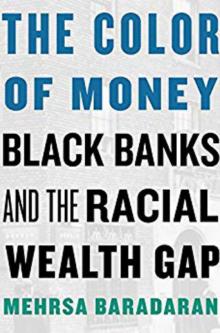Read The Color of Money Storyline:
In 1863 black communities owned less than 1 percent of total U.S.wealth. Today that number has barely budged. Mehrsa Baradaran pursues
this wealth gap by focusing on black banks. She challenges the myth that
black banking is the solution to the racial wealth gap and argues that
black communities can never accumulate wealth in a segregated economy.Review
Combining a rich historical sweep with in-depth analysis of
the mechanics of banking, Baradaran unpacks the brutal dilemma facing
black banks―how to create black wealth in the context of a segregated
and unequal ‘Jim Crow’ economy. Baradaran’s brilliant and devastating
analysis leads to an irrefutable conclusion: the racial wealth gap is
the product of state law and public policy, and will only be reversed
when the same governmental tools that created segregation and
discrimination are deployed to end it. (Beryl Satter, author of Family Properties: How the Struggle over Race and Real Estate Transformed Chicago and Urban America)Observers
as different in time and ideology as Frederick Douglass, Malcolm X, and
Ronald Reagan have argued that black banks represent perhaps the best
hope for securing a just society. As Baradaran powerfully maintains,
however, any effort to restrict responsibility to banks alone or black
people alone will always be doomed to failure. A swift, beautiful, and
chastening book, The Color of Money reminds us, yet again, that
black poverty is not really an economic problem, but rather a political
problem requiring political solutions. (N. D. B. Connolly, author of A World More Concrete: Real Estate and the Remaking of Jim Crow South Florida)Baradaran
provides a pivotal understanding of how our racialized history
structured the disparity between the black and white share of the
nation’s wealth and how it continues to inhibit the development of black
capital and black banks. Her book puts to rest, once and for all, the
trope that self-help, buying black, and black banking are the panacea to
black prosperity. (Darrick Hamilton, The New School for Social
Research)In this important book, law professor Mehrsa Baradaran
uses the history of black banking from emancipation to the present as a
vehicle for exploring the origins and persistence of the racial wealth
gap in America. This is more than a history of financial institutions,
though. It is a probing, revelatory study of racism and capitalism in
the making of modern America, one that reveals how segregation, racial
prejudice, and black economic disadvantage became mutually reinforcing.
(Andrew W. Kahrl, University of Virginia)Baradaran…provides a
deep accounting of how America got to a point where a median white
family has 13 times more wealth than the median black family. (Gillian
B. White The Atlantic 2017-09-01)Baradaran’s point is to
show how white and Black Americans effectively live in two separate
economies…As a work of history, the book contains a disturbingly
coherent narrative of racist plunder spanning from the Freedman’s Bureau
bank to today’s payday lenders…Baradaran’s book is a must read for
anyone interested in closing America’s racial wealth gap. (Guy Emerson
Mount Black Perspectives 2017-12-05)
Pages of The Color of Money :
